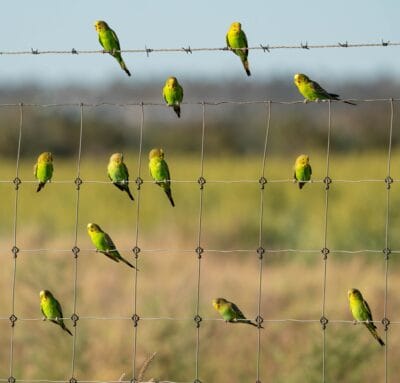Australian National Budgerigar Council
Wild Budgerigars
Wild Budgerigars | The Native Budgie
Budgerigars, otherwise known as budgies, the budgeriger, bugrigar, or the shell parakeet, are a popular pet bird species worldwide. In fact, they are the world’s third most popular pet! However, were you aware that they also exist in the droves in outback Australia? Wild budgerigars are a common sight in various parts of the country, west of the Great Dividing Range. The wild budgies travel in massive murmations, often darkening the sky. In this article, we will delve deeper into their habitat, diet, behavior, and more.
Habitat of Wild Budgerigars
Wild budgerigars are native to Australia. To that end, they inhabit a range of environments, including arid and semi-arid regions, grasslands, and scrublands. To that end, they are highly adaptable birds, and they have been able to thrive in various habitats.

Diet, Behaviour & Wild Budgie Breeding
Wild budgerigars or budgies are seed-eating birds and mainly feed on grass and weed seeds. To that end, they feed on seeds from a variety of plants, including spinifex grass, saltbush, and acacia. In their native environment, they will forage for food in flocks and often feed on the ground. Moreover, they are highly social birds and live in flocks or murmations of up to several thousand individuals. They also vocalise loudly, and their calls are audible from quite a distance. Breeding is an essential aspect of the life of wild budgerigars. To that end, breeding usually occurs during the rainy season, which typically falls between December and March in Australia. During this time, wild budgerigars’ bond as breeding pairs. The female budgies lay eggs in tree hollows or other suitable cavities, and crop feed her young.
Conservation Status
Wild budgerigars are not a threatened species, and their conservation status is of “Least Concern”. However, concerns have arisen about the impact of climate change and habitat loss on their populations in some regions.
Conclusion
Wild budgerigars are fascinating birds with a rich history in Australia. Moreover, they are highly adaptable and have been able to thrive in various habitats. As their habitat faces threats from climate change and habitat loss, it is crucial that we support conservation efforts. This extends not only to birds, but other native Australian wildlife.
Whether you call them budgerigars, budgies, a budgeriger, bugrigar, or shell parakeet, one thing is common – they will capture your heart.
